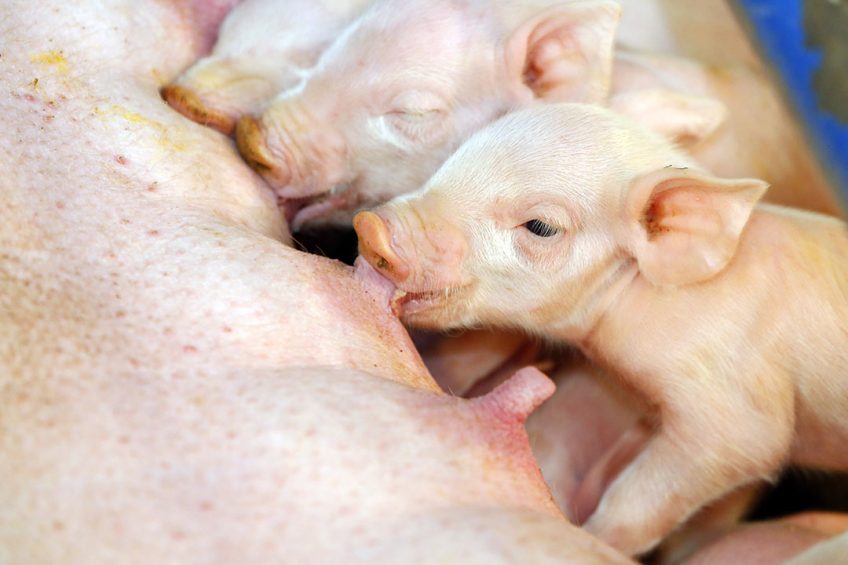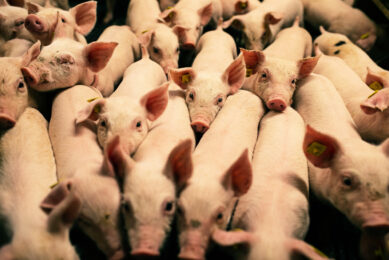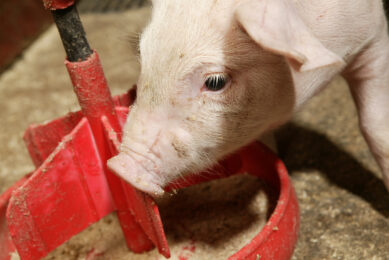Encouraging piglets to eat more creep feed

Consuming creep feed can help piglets to successfully bridge the gap from milk to solid feed at weaning.
Due to many factors, weaning often leads to a low feed (energy) intake, gastro-intestinal problems, gut microbiota dysbiosis, reduced growth and behavioural disturbances after weaning, thereby reducing health and welfare. Stimulating the consumption of solid feed prior to weaning, i.e. creep feeding, may improve piglet adaptation after weaning, but factors influencing creep feed intake in piglets are unclear up to now.
Recent research at Wageningen University and Research in the Netherlands focused on 2 potentially impacting factors in getting piglets to eat creep feed. They wondered whether a low energy intake from milk, by means of maternal feed restriction, would make a difference. And they also aimed to establish the effect of presenting creep feed in an exploratory and playful context by means of a foraging-stimulating play-feeder.
The study was set up with 2 different sow feeding strategies and 2 piglet feeding strategies prior to weaning, leading to eventually 4 ‘experimental paths’ piglets could have taken.
During the trial, the scientists carefully monitored their characteristics, being:
- piglet growth;
- piglet behaviours;
- which animals were the creep feed eaters and what was the piglets’ feed intake;
- body lesions and damage on piglets; and
- faecal consistency scores of piglets.
Sow feeding strategies
All sows were fed the same level of commercially available sow diet until day 9 post-partum. From day 10 post-partum onwards, sows were fed in 3 feedings and received either…
- 6.5 kg feed per day (full-fed, 19 sows); or
- 3.25 kg feed per day (restrictedly-fed, 18 sows).
That created a contrast in energy supply from milk. The milk production of sows on a restrictive diet was indeed lower compared to full-fed sows, at least between day 17-24 of lactation, and the milk of restrictedly-fed sows contained a lower percentage of fat. Moreover, the restrictedly-fed sows lost more body weight between day 10-24 than full-fed sows.
Piglet feeding strategies
From day 4 after birth, the litters were either creep-fed…
- in a round conventional feeder (18 litters, equally divided over the two sow groups); or
- in a foraging-stimulating ‘play-feeder’ (19 litters, 10 with full-fed sows, 9 with restrictedly-fed sows).
The play-feeder was created by attaching canvas clothes, braided natural cotton ropes and PVC spiral tubes to the conventional feeder. 2 days prior to weaning, the creep feed was mixed with a nursery diet to familiarise piglets to the nursery diet before weaning.
At weaning at roughly 24 days of age, a subset of 144 piglets was relocated in 2 weaner rooms in 2 batches; they were fed the nursery diet ad lib. The pre-weaning treatments were not reinforced after weaning, so all weaner pens were identical and equipped with a conventional feed trough that was unfamiliar to all piglets. The experiment ended when piglets were 39 days of age.
Piglets before weaning
Behaviour: The play-feeder increased the time spent exploring the feeder by 3.5 to 6 times and attracted more piglets to visit the feeder, irrespective of the feed intake level of the sow. The treatments did not affect time spent eating creep feed at day 16, however piglets from a restrictedly-fed sow doubled their time spent eating compared to piglets from full-fed sows at day 23. Time spent exploring the feeder correlated with time spent eating at all observation days.
Creep feed intake: Creep feed intake was low up to day 17. About 50% of the total feed intake was consumed during the last 2 days prior to weaning. Piglets from restrictedly-fed sows consumed more feed the last 2 days before weaning than piglets from full-fed sows. At weaning, litters of restrictedly-fed sows also had double as much eaters than litters of full-fed sows. The play-feeder did not influence creep feed intake, but piglets of restrictedly-fed sows that had access to a play-feeder were more likely to become eaters from an earlier age.
Piglet growth and weight: Piglets from sows fed restrictedly gained less weight between day 10-17, between day 17-24 and overall between day 10-24 than piglets from full-fed sows. Piglets from the first group tended to weigh less at day 17 and weighed less at weaning.
Piglets after weaning
Eating: Weaner piglets which, in an earlier stage were fed from a play-feeder in their farrowing pens, spent more time eating at week 2 after weaning. Moreover, piglets familiar with the play-feeder showed more drinking than control piglets at week 1 and week 2 post-weaning. Piglets from restrictedly-fed sows were more often seen drinking at week 2 post-weaning than piglets from full-fed sows.
Exploratory behaviour: Piglets from sows fed restrictedly, had a higher level of exploration towards the feed(er) and drinker compared to piglets from full-fed sows at week 1 post-weaning. Moreover, piglets from sows fed restrictedly spent more time on exploring the environment at week 1 post-weaning compared to the other piglets. Ear biting was performed to a lesser extent by piglets from restrictedly-fed sows than by piglets from full-fed sows at week 2 post-weaning. By then, there were less weaner piglets that were fed from a play-feeder before weaning with body lesions (Table 1), ear damage (within the group of piglets from full-fed sows) and tail damage (within the group of piglets from restrictedly-fed sows).
Feed intake and growth: Maternal feed restriction and the play-feeder during lactation increased the average daily feed intake (ADFI) and average daily gain (ADG) after weaning, with the effect of the play-feeder lasting until the end of the experiment. Maternal feed restriction improved the intake of feed until day 5 post-weaning and improved growth until day 2 post-weaning. Although piglets from restrictedly-fed sows weighed less at weaning compared to piglets from full-fed sows, they did not differ anymore in body weight at the end of the trial. The play-feeder improved ADFI and ADG during the two weeks after weaning, resulting in a higher body weight at the end of the trial. Moreover, post-weaning diarrhoea was less prevalent, less severe and shorter in duration as result of the provision of the play-feeder before weaning (Table 1).
Effects of maternal feed restriction
Maternal feed restriction by 50% resulted in a 16% lower ADG of piglets during lactation and a 12% lower weaning weight. Hunger as homeostatic drive was likely the biggest motivator for these piglets to eat creep feed. The results thus support that litters that grow less may try to compensate by consuming more creep feed. Piglets from these litters turned out to be eating 60 g/day more and grew 160 g/d faster in the first few days post-weaning compared to piglets reared by full-fed sows. Although these piglets seemed to have experienced lower levels of stress and/or food neophobia due to a more gradual weaning transition, maternal feed restriction is not recommended, because it is detrimental for piglet welfare (at least before weaning), sow welfare and sow future reproductive performance.
Effects of the play-feeder
The play-feeder was successful in eliciting and sustaining exploratory behaviour in suckling piglets. It showed greater, broader and longer-term beneficial post-weaning effects, as feed intake and growth of piglets provided with this play-feeder before weaning were significantly improved by 15% for (at least) 2 weeks post-weaning, resulting in a 5% higher body weight at day 15 post-weaning (end of trial). The play-feeder also reduced the prevalence (17 vs. 61%), duration (by 1.3 days) and severity of diarrhoea (by 50%) and decreased the number of body lesions and the number of piglets with tail or ear damage.
It has been hypothesised that a higher feed intake and growth, an increase in faecal consistency and a decrease in maladaptive behaviour of weaner piglets are related to each other and may all result from lower levels of stress and/or food neophobia at weaning.
- Firstly, piglets having met the play-feeder might have been better acquainted with the sight and smell of the nursery feed compared to piglets from the control group, as result of a higher feeder visiting time and more piglets visiting;
- Secondly, this group of piglets might have developed a positive association between solid feed and object play;
- Thirdly, the higher frequency of manipulating behaviours on the toys of the play-feeder, such as chewing, might have facilitated the transition from exploratory to eating behaviour;
- Lastly, the provision of play-objects before weaning, thereby eliciting an early play experience for piglets, might also improve their ability to emotionally cope with weaning.
Reduction in weaning stress
In conclusion, litters reared by restrictedly-fed sows grew less, had more eaters and ate more before weaning, suggesting that pre-weaning feed intake is at least partly homeostatically driven. This pre-weaning acquaintance with feed improved feed intake and growth in the first days after weaning, resulting in a ‘catch-up effect’ in post-weaning body weight.
The play-feeder, which was only provided before weaning, encouraged piglets to explore and play with the feeder and sustained piglets’ interest up to weaning. The main finding of this study was that the play-feeder had no effect on creep feed intake in itself, but remarkably eased the weaning transition, as reflected in improved post-weaning feed intake and growth and reduced diarrhoea and body damage. Possibly, providing a play-feeder after weaning would be even more beneficial for piglet welfare and performance.
This trial implies that providing toys at the creep feeder can be considered as an easy applicable enrichment and feeding strategy to reduce weaning stress and improve the health, welfare and productivity of piglets around weaning. The mechanism(s) underlying this beneficial effect are not yet well understood and deserve further attention.
* This article is an approved and abridged version of a scientific article in Scientific Reports, a publication by Nature. The original article was written by Anouschka Middelkoop, Natasja Costermans, Bas Kemp and J. Elizabeth Bolhuis, attached to WUR.
The article is part of symposium ‘Early feed intake and welfare in pigs’ on October 9, 2020, in Wageningen, the Netherlands. The symposium is organised on behalf of the PhD defence of Anouschka Middelkoop and will be held in English.







